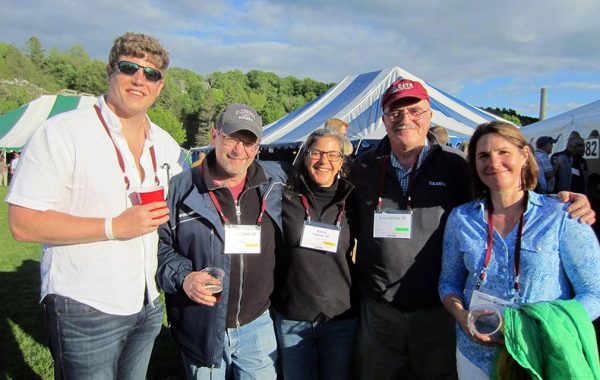Spring 2018
A politician’s remarks
I was impressed by Rep. Claudia Tenney (R-NY) after reading about her in the Scene (“From Colgate’s hill to Capitol Hill,” winter 2018). In view of the high level of partisanship and even bitterness currently prevailing in Washington, I was heartened to read that her “freshman class” in the House “made a commitment to civility — to reach out to each other in an effort to change the tone of our current political discourse.” She went on to point out how “we all play together, Republican and Democrat … on the Congressional Softball Team.”
Consequently, I was taken aback and extremely disappointed to read the story in the Feb. 22 edition of the New York Times quoting her as saying that “so many of these people that commit the mass murders end up being Democrats.” This interview took place just one week after the horrible shootings in Parkland, Fla. The Times story reported that, in a statement later that day, the Congresswoman did not provide information regarding her claim but elaborated as follows: “I am fed up with the media and liberals attempting to politicize tragedies and demonize law-abiding gun owners and conservative Americans every time there is a horrible tragedy.”
Is this an example of her “civility”?
Robert Malley ’66
Westerly, R.I.
A helpful resource
I am writing to thank Julie Rosenbaum Skolnick ’90 for her essay, “With Understanding Comes Calm” (winter 2018). As an elementary school teacher, most of my free time involves school in some way: creating lesson plans, using formative assessments to guide my teaching, or wrestling over students’ many issues while swimming my daily laps (a pastime I started my sophomore year at Colgate).
By this time in the school year, teachers know their students well: They know which children have special needs and have tried many strategies to help children succeed. We are wracking our brains trying to come up with new ideas.
The opening line of Julie’s essay caught my attention immediately. The students I find most challenging are those for whom the teacher’s question is, “Why is the child who pays the least attention the one who knows all the answers?”
I have shared Julie’s article with my assistant principal and our lead teacher. We are excited about the resource that Julie may become for those of us who would like to understand more about these 2e children and to implement plans so that, as Julie says, “we can preserve these students’ self-esteem and they can participate meaningfully in the classroom.”
Given the complexity of children’s lives, pressures from social media, and what seems like an increasingly disturbing disconnect of young people from following the “Golden Rule,” I hope educators use resources like Julie to enable students to participate meaningfully in the classroom and the rest of their communities.
Thank you, Julie!
Anne (Thomas) Steger ’78
Rochester, N.Y.
Colgate values
I recently saw the true value of a Colgate education — to spur us to think and to act! I was at an organizational meeting about political activism with about 150 people from Bergen County (N.J.). Not only was there the one Colgate alumna there (myself) but two other women, from the classes of ’83 and ’84. (Perhaps there were even more, but that’s who I recognized.) What a great showing and testament to an education that values thought and action.
Nancy Cohen ’83
Hillsdale, N.J.
Saluting student writers
 These five essays (“Applying Themselves,” autumn 2017) were all inspirational reads, and each of them goes to show how multidimensional and introspective Colgate students are at their core. Thank you for highlighting and sharing these student essays, as they not only remind us alumni of how well rounded today’s Colgate students continue to be, but also keep us tuned in to the motivation and stories we each had in our own Colgate essays as we further build our own characters well beyond our Colgate years. The accompanying artwork is stunning, and brings each story to life, too — kudos to the artist as well as our student writers.
These five essays (“Applying Themselves,” autumn 2017) were all inspirational reads, and each of them goes to show how multidimensional and introspective Colgate students are at their core. Thank you for highlighting and sharing these student essays, as they not only remind us alumni of how well rounded today’s Colgate students continue to be, but also keep us tuned in to the motivation and stories we each had in our own Colgate essays as we further build our own characters well beyond our Colgate years. The accompanying artwork is stunning, and brings each story to life, too — kudos to the artist as well as our student writers.
Lisa Lee ’12
Fresh Meadows, N.Y.
My great hero
Bruce Selleck ’71 was much more than a former professor to me: He changed my life. Bruce cultivated my potential. He did this, as with all of his students, by becoming involved in my life and making me feel that I mattered.
I wrote down a list of all the ways Bruce positively influenced me during my years at Colgate. I’ll share some of this list here to illuminate how important Bruce was to me personally and to illustrate the approach he applied to many students. I did not know Bruce before I took his Sed Strat course in my sophomore year. I was electrified by the material, and Bruce could see that. Bruce agreed to advise a January plan course (Design of Museum Display) that entailed visiting rock outcrops in Cherry Valley, N.Y., measuring section, collecting, slabbing and polishing rocks, making thin-sections, and then analyzing and writing up the material. Bruce showed me how to do all of these things and I have used this skill set on many occasions since. Bruce encouraged me to apply for a summer research stipend, which I was granted. I visited many outcrops with Bruce that summer and was also able to attend part of the geology off-campus study group. That research resulted in a Colgate Journal of the Sciences article and my first presentation at a scientific conference (1981 NEGSA). The January 1981 field course to the Florida Keys and Sanibel-Captiva Islands cemented my reverence of Bruce. All of these experiences imbued me with a confidence I would not have developed had Bruce not given me early attention. With Bruce’s assistance and letters of recommendation, I was able to turn my experiences into admission to graduate school at UVM.
L to R: Sam Ely ’12, Ron Parker ’82, Nancy Caplow ’82, Professor Bruce Selleck ’71, and Denise Waite ’87 at Reunion 2017
In the years after I graduated, Bruce remained a strong positive influence and acted as a colleague. I am aware of many former students who have engaged in significant collaboration with Bruce through the years. Bruce’s students became a part of his extended family.
I was stunned to learn my Great Hero had died. I am so thankful I attended my 35th Reunion, where I was able to spend time with Bruce. I last saw him that Saturday when Nancy Caplow ’82 and I walked him to his truck to say goodbye. In the ensuing conversation, we reviewed our maladies from advancing in age. Bruce said, “Do you know what all these aches and pains from growing old mean? It means you haven’t died yet.” Prescient, chilling, and wonderful. Bruce made a profound, deep, and indelible impact on my life, and I am so appreciative of that. I can scarcely imagine the world without him.
Ronald L. Parker ’82
Centennial, Colo.
Memories of a mentor
“A Life Examined” (winter 2018) came as a real gift to this early beneficiary of Professor Jerry Balmuth’s brilliant and energetic mind. The wonderful photo of Jerry in his Plato cap is now on my wall to remind me daily of the inspiring gift he was to me — to motivate me to continue to critically engage the pressing issues of our day.
All the various contributors to this tribute expressed so well Jerry’s living impact on my life. On one occasion when he was late to a 4 p.m. class, we began to wonder if we should leave. Just then, he entered the classroom and without a word, snapped off the overhead lights. The orange glow of a late winter sunset suffused the hushed space in which we sat, and our teacher kept silence with us, rapt with us by the beauty we had overlooked. It was a lesson that changed my life.
Thank you also for publishing at length the testimonial of Juan Flores ’80, the first Chamoro student to graduate from Colgate. I share his appreciation for the iconic photo of our first woman of color dean of the faculty, Tracey Hucks ’87.
I also appreciated the Scene making clear the degree of respect that readers are required to show for those with whose opinions or life choices they disagree. These are key values we must uphold — and carry forward the legacy of great teachers like Jerome Balmuth.
Richard Schaper ’67
Mill Valley, Calif.
Last night I read the tribute to Jerry Balmuth. You did a terrific job; you captured him to a T. Although I never had him as a professor, I felt as if I did. While I was at Colgate, the philosophy and religion department with Balmuth, [Steve] Hartshorne, [Huntington] Terrell, and [Wanda Warren] Berry seemed to dominate the campus. There were so many stories about these guys that you felt you knew them all personally.
After freshman year of philosophy and religion with Berry and Terrell, which I managed to pass, I quickly decided I was out of my league and would need to find another field to concentrate in. History was much more to my liking. Of course, we had our own lions in the history department, but that is a different story.
The tribute to Dr. Balmuth brought back a flood of great memories.
Robert W. Locke ’68
Towson, Md.
Talking about Torchlight
Much has been said about the Torchlight Ceremony, and Colgate’s president is to be commended for discussing the issue in a balanced and transparent manner.
The “Torch of Knowledge” was around before fascism, having nothing to do with the Tiki torches in Virginia. To flee from the Colgate symbol of knowledge because fascists have commandeered the symbol of a flaming light is giving in to their ideology, letting them claim victory. We are not, I hope, so intellectually feeble to allow that.
There are legitimate concerns about safety of the wood torches, and the brass torches that have been adopted will go a long way toward making the march down the hill safer.
As for fascism, never forget that a generation of Colgate students actually went to war against fascism, some dying in the process. They did not see any connection between the torchlight procession, our torch, and the Nazi rallies. Why should we, now, be offended?
Colgate began in 1819. Because a German dictator used a torch in the 1930s to promote a fascist ideology, don’t throw out our symbol of knowledge in the 21st century. What some in our Colgate community want to do is take a snapshot of the 1930s and superimpose today’s values and beliefs on that moment. Only problem is, our Colgate torch — which has nothing to do with that time or place — has been Photoshopped in. Let’s not be fooled. Our torch wasn’t in Germany when Colgate students marched off to war to defeat fascism and it wasn’t in Virginia when white supremacists tried to spread their hate. Our torch lights the way to victory over these ideologies by spreading knowledge, not fear.
Bruce Healey ’84
Cincinnati, Ohio
The Scene welcomes letters. We reserve the right to decide whether a letter is acceptable for publication and to edit for accuracy, clarity, and length. Letters deemed potentially libelous or that malign a person or group will not be published. Letters should not exceed 250 words. You can reach us by mail, or e-mail sceneletters@colgate.edu. Please include your full name, class year if applicable, address, phone number, and/or e-mail address. If we receive many letters on a given topic, we will run a representative sample of the opinions expressed.








